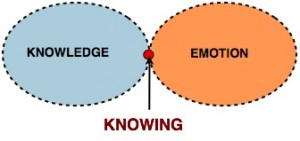
Imagine your brain.
Hopefully, you saw a picture of a human brain at some point in life so you can imagine it now ;). A rough idea is enough.
The human brain
The cerebrum with its gray matter is the largest part of your brain. It lies around most other structures of the brain and plays a role in building intelligence and wisdom. (The heart and the gut system play a role as well.)
The cerebrum is divided into the right and left hemispheres. The common generalization is that the left hemisphere is responsible for analysis, rational thought, linearity or order, while the right hemisphere is responsible for synthesis, emotion, non-linearity and art. In practice, the division is not so clear as the same function can be present in both hemispheres but in different degrees. But there is usually a strong dominance of one hemisphere or another for the given task.
 Both hemispheres are connected by corpus callosum, a thick band of nerve fibers in the middle of the brain. The corpus callosum allows the hemispheres to communicate to each other by exchanging motor, sensory, and cognitive information. In a well-functioning brain, there is a constant vibration in the corpus callosum, where information and learned patterns cross with the feelings and holistic views.
Both hemispheres are connected by corpus callosum, a thick band of nerve fibers in the middle of the brain. The corpus callosum allows the hemispheres to communicate to each other by exchanging motor, sensory, and cognitive information. In a well-functioning brain, there is a constant vibration in the corpus callosum, where information and learned patterns cross with the feelings and holistic views.
The Loop
So, we have Knowledge and Emotion, which in a simplified view can refer to the left and right hemispheres, accordingly. And there is the meeting point, the connection between them – the corpus callosum. And this is a point where the Intelligent Knowing occurs.
We can also look at the Knowledge-Emotion loop somewhat differently. The function of the brain is to acquire Knowledge. All the learning we do and memories we store become the ingredients of Knowledge. The function of the heart-gut system is to supervise the Flow and feel Emotion. The Inspired Knowing occurs then in the heart. Later the Intelligent and Inspired Knowings are combined.
In practice, this high level integration of Knowledge and Emotion is more complex than I’ve just described. There are possibly many loops of communication between brain and heart, based on various networks of nerves such as solar plexus.
Knowledge vs Knowing
Note that Knowing is very different than Knowledge. The key understanding is that Knowledge is the result of learning, an outcome of inquiry, analysis, reflection and conclusion. It can be collected, explained, structured or enumerated. It is a half of the whole. The other half is Emotion. Emotion allows us to experience and value the experience, to color things and give additional meaning.
Knowing is the spark at intersection, occurring in a moment in which you paint Knowledge and Emotion on the canvas of perception. It is an integration process where flow happens both ways.
Knowledge is external. Knowing is internal.
Knowledge is historical. Knowing is in a moment.
Knowledge is common. Knowing is personal.
Knowledge is experienced or shared by many. Knowing is experienced by you.
Knowledge is based on collected observations. Knowing is based on a perception in a moment.
Knowledge is passive. Knowing is active.
Knowledge is a product. Knowing is a process.
Life is a dynamic experience. Knowledge is the necessary foundation of life, but it has to be constantly updated and transformed. Sometimes in a revolutionary way.
When Knowledge is challenged, learning will take place. Old patterns will be questioned and replaced by new ones. This is only allowed if your Emotional Self accepts it. So, any significant progress requires an informative balance between Emotion and Knowledge (rational thought). And this equilibrium is achieved at the point of Knowing.
Tell me, are you Knowledge-able or Knowing-able?
Your Inner Knowing is already there. Recognize it.
***
For those who pay attention, this short post is of course about Intuition. From a different point view.
***
Photo copyright by Moyan Brenn. Photo available under the Creative Commons license on Flickr.
***
